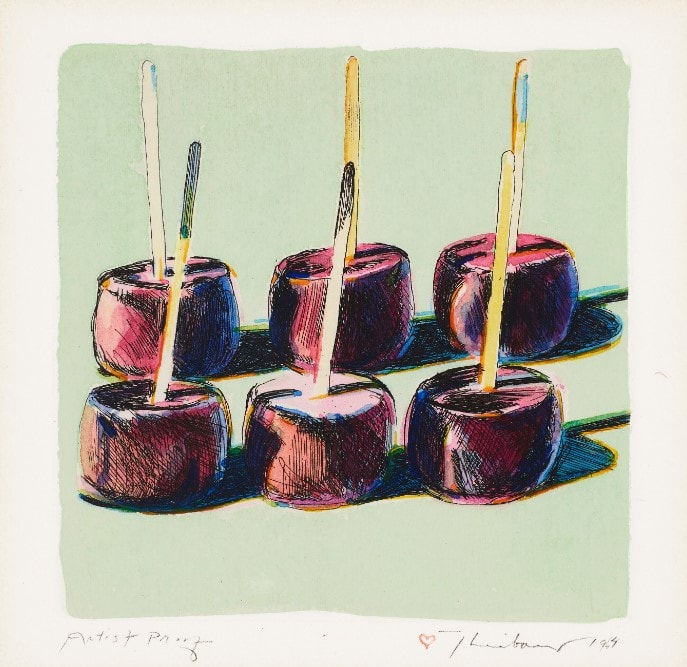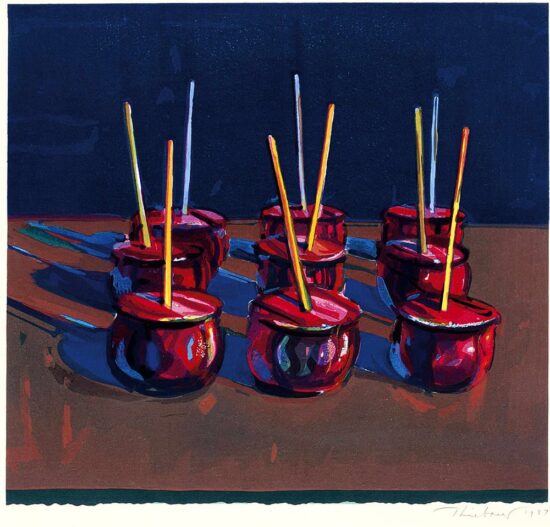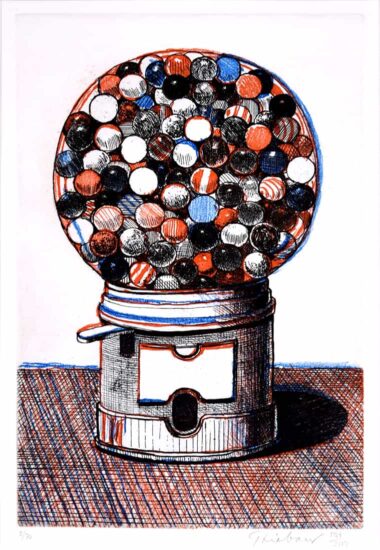Thiebaud’s work has left a lasting impact on the art world, with his unique style and subject matter capturing the attention of both colleagues and audiences. His food paintings, in particular, gained recognition after he met the New York art dealer Allan Stone in 1961. Stone's representation helped Thiebaud’s work reach a wider audience and solidified his place in the art scene. Over the years, major art institutions and galleries across the Bay Area have showcased Thiebaud’s work, further cementing his legacy as a prominent artist. Thiebaud: Biography, Art, Paintings & Prints
What are the key influences on Wayne Thiebaud's artistic style?
Wayne Thiebaud's artistic style is influenced by his past work as a commercial artist, his interest in light and shadow from his time at Disney Studios, and the vibrant colors and shapes seen in everyday objects. These influences combined to create his iconic pop art paintings.
Key Highlights
- Wayne Thiebaud is a renowned American painter known for his unique style that blends pop art and realism.
- He was awarded the National Medal of Arts for his contributions the art world.
- Thiebaud is famous for his paintings of cakes and pastries, as well as his vibrant San Francisco streetscapes.
- His thick paint application and use of shadow effects create a sense of texture and depth in his artwork.
- Thiebaud's paintings capture the essence of everyday Americana, making him an influential figure in American art.
- His prints and paintings are celebrated around the world for their vibrant colors and bold compositions.
Introduction
Wayne Thiebaud is an American painter and printmaker whose unique style has made him one of the most celebrated artists of his generation. Born on November 15, 1920, in Mesa, Arizona, Thiebaud's artistic journey began at a young age. He grew up in a large Mormon family and later moved to Long Beach, California. Thiebaud's early influences came from his experiences in Mesa and Long Beach, as well as his love for cartoons and commercial art. These early influences, along with his background as a graphic designer and cartoonist, shaped his artistic style and set the foundation for his later works. Thiebaud's success as a working artist has been recognized through numerous awards and honors, including the National Medal of Arts, for his contributions to the art world and his dedication to teaching and mentoring future generations of artists.
Thiebaud's artistic career took off during his time at the Frank Wiggins Trade School in Los Angeles, where he studied commercial art. He further honed his skills through a summer apprenticeship program at Walt Disney Studios, where he worked on beloved characters like Goofy and Pinocchio. Thiebaud's work in the animation department sparked his interest in fine art, leading him to explore different mediums and styles. After high school, Thiebaud continued to pursue his passion for art, eventually becoming one of the most renowned artists of the 20th century, with his experiences during World War II shaping his artistic perspective and career.
Early Life and Influences
Wayne Thiebaud's early life in Mesa, Arizona, shaped his artistic perspective. Inspired by cartoonists and commercial art, he honed his skills before transitioning to fine art.
Growing up in Mesa, Arizona
Wayne Thiebaud was born into a large Mormon family in Mesa, Arizona. His upbringing in a close-knit community instilled in him a strong sense of family values and community spirit. Thiebaud's early years in Mesa shaped his view of the world and influenced his artistic style. Later, his family moved to Long Beach, California, where Thiebaud continued to develop his artistic skills and explore his passion for art. He also lived for a number of years on his uncle's ranch in Utah, as his large Mormon family retained roots in the Southwest.
Inspiration from Cartoonists and Commercial Art
During his time in Long Beach, Thiebaud found inspiration in the world of cartoons and commercial art. He was particularly drawn to the work being done at Walt Disney Studios, where he later had the opportunity to work as a summer apprentice. Thiebaud's experiences at Disney fueled his love for animation and brought him closer to the world of fine art. The influence of cartoons and commercial art, as well as Thiebaud's experience as a commercial artist at Rexall Drug Company, can be seen in his later works, as he combines elements of popular culture with his unique artistic style.
Artistic Journey
Wayne Thiebaud's artistic journey is marked by his transition from commercial art to fine art. After his time at Walt Disney Studios, Thiebaud continued his education in art, attending California State University in Sacramento. It was during this time that he began to explore different mediums and techniques, ultimately finding his signature style. Thiebaud's transition from commercial art to fine art allowed him to explore his creativity and delve into subject matters that were close to his heart, inspired by the wonderful people he encountered in the commercial art world.
Transition from Commercial Art to Fine Art
Thiebaud's transition from commercial art to fine art was a pivotal moment in his career. After completing his education at California State University in Sacramento, Thiebaud began teaching at Sacramento City College. This experience allowed him to further develop his own artistic style while imparting his knowledge to aspiring artists. Thiebaud's time at Sacramento City College, as well as his education at San Jose State University, cemented his passion for fine art and set him on the path to becoming one of the most influential artists of his generation.
Exploring the Everyday: The Theme of Americana
Thiebaud's exploration of the everyday is a recurring theme in his artwork. He captures the essence of Americana through his paintings of cakes, pastries, and everyday objects. Thiebaud's unique perspective on American culture and his ability to elevate seemingly ordinary subjects to the realm of fine art, as seen in his iconic thiebaud’s paintings, have made him a prominent figure in American art. His paintings resonate with viewers, evoking a sense of nostalgia and familiarity with the American experience.
Signature Style and Techniques
Wayne Thiebaud's signature style, influenced by his mentor and fellow Pop artist Andy Warhol, is characterized by his thick paint application and use of shadow effects, reminiscent of Willem de Kooning's gestural brushstrokes. His paintings have a tactile quality that draws viewers in and invites them to explore the texture and depth of his artwork. Thiebaud's use of light and color in composition creates a sense of vibrancy and movement in his paintings. His unique techniques, inspired by Warhol's use of media images, allow him to capture the essence of his subjects and create a visual experience that is both captivating and evocative.
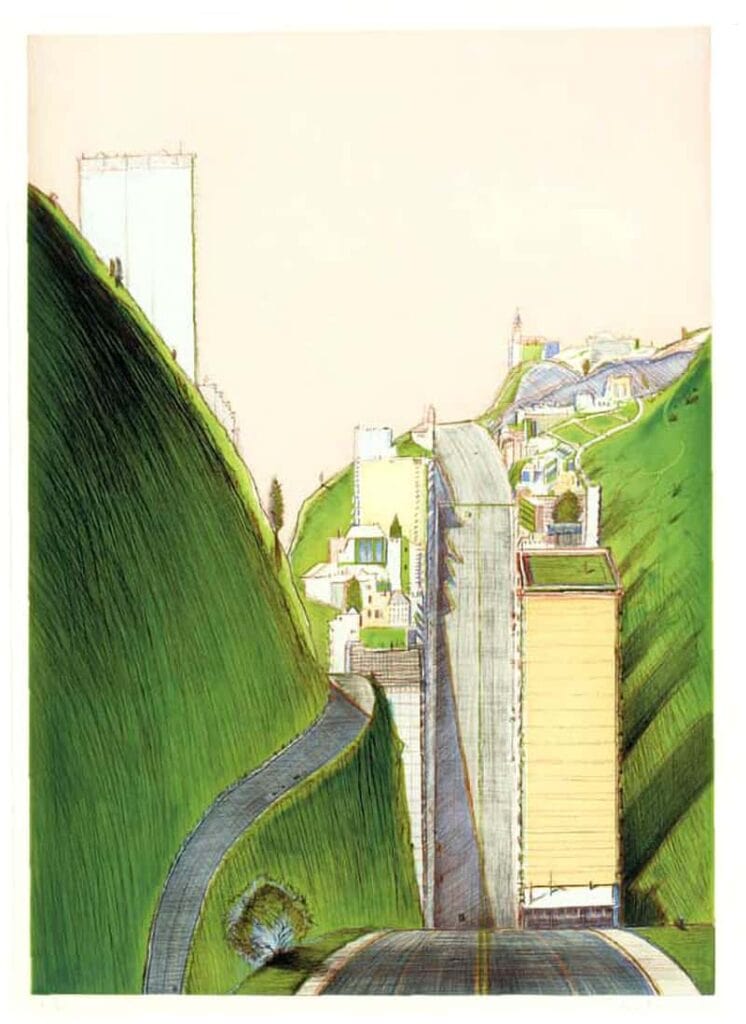
Thick Paint Application and Shadow Effects
Thiebaud's thick paint application and use of shadow effects are distinctive elements of his artwork. He applies paint in layers, building up texture and depth to create three-dimensional effects on the canvas, often using paint cans as his subject matter. This technique gives his paintings a tactile quality, inviting viewers to engage with the artwork on a deeper level. Thiebaud's use of shadow effects adds another layer of depth and dimension to his paintings, creating a sense of realism and capturing the play of light and shadow in everyday objects.
The Use of Light and Color in Composition
Thiebaud's use of light and color in composition is an integral part of his artistic style. He carefully selects colors to create harmonious compositions that evoke a sense of vibrancy and life, drawing inspiration from various sources such as Bonnard, Matisse, German expressionists, Indian miniature painting, and Chinese painting. Thiebaud's skillful use of light effects adds depth and dimension to his paintings, capturing the interplay between light and shadow. His compositions are carefully arranged, with a keen eye for balance and visual impact. Thiebaud's mastery of color composition and light effects creates a visual experience that is both captivating and immersive.
Iconic Works
Delving into "Cakes" and "Pies," Wayne Thiebaud's iconic works mesmerize with their vibrant realism and playful compositions. The luscious textures of his paintings of cakes and pies evoke a sense of indulgence and nostalgia, capturing the essence of American culture. Thiebaud's "San Francisco Streetscapes" and "Shop Windows" breathe life into city streets, portraying a dynamic urban landscape with a unique blend of colors and perspective, showcasing his mastery in capturing everyday scenes with a touch of whimsy and charm.
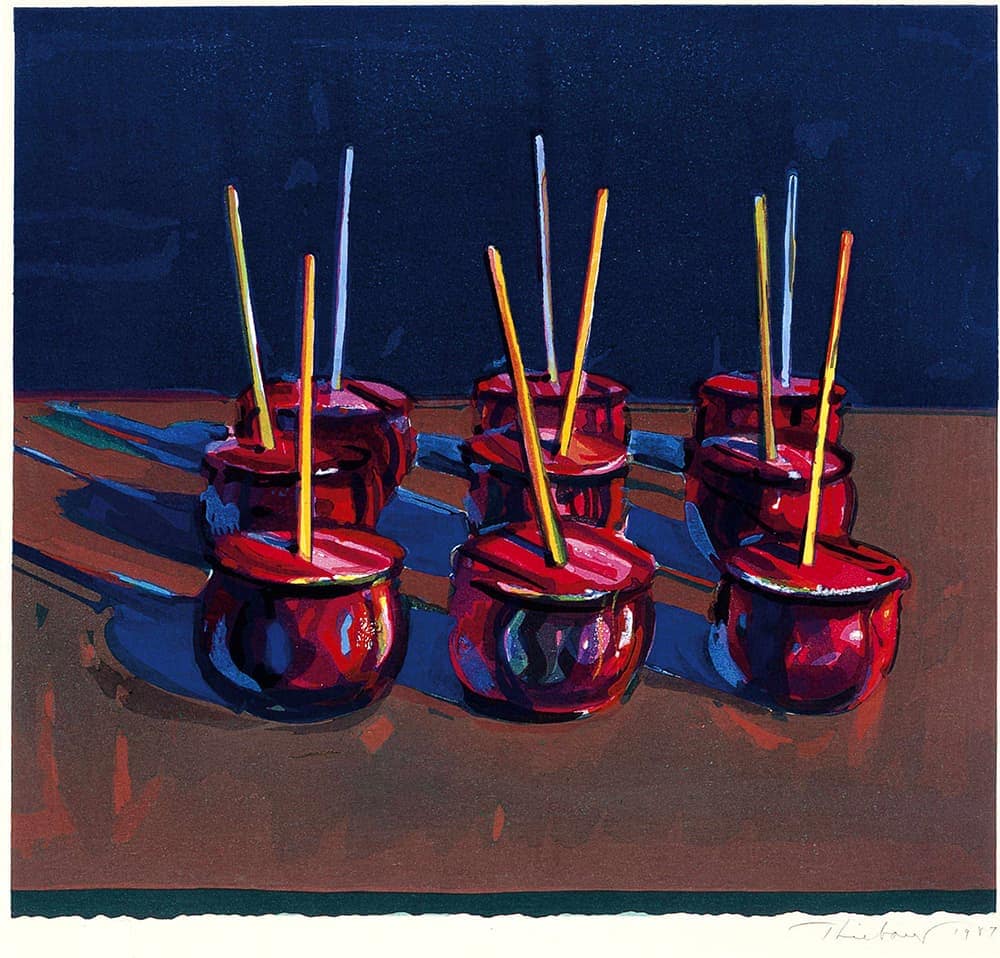
Delving into "Cakes" and "Pies"
Wayne Thiebaud's iconic works include his series of paintings featuring cakes and pies. These vibrant and enticing paintings have become synonymous with his name and are considered some of his most recognizable works. Thiebaud's depictions of cakes and pies, along with other food products such as candy and ice cream cones, hot dogs, and pastries, capture the texture, color, and allure of these delectable treats. His unique blend of pop art and realism brings a sense of playfulness and nostalgia to these everyday objects, elevating them to the realm of fine art.
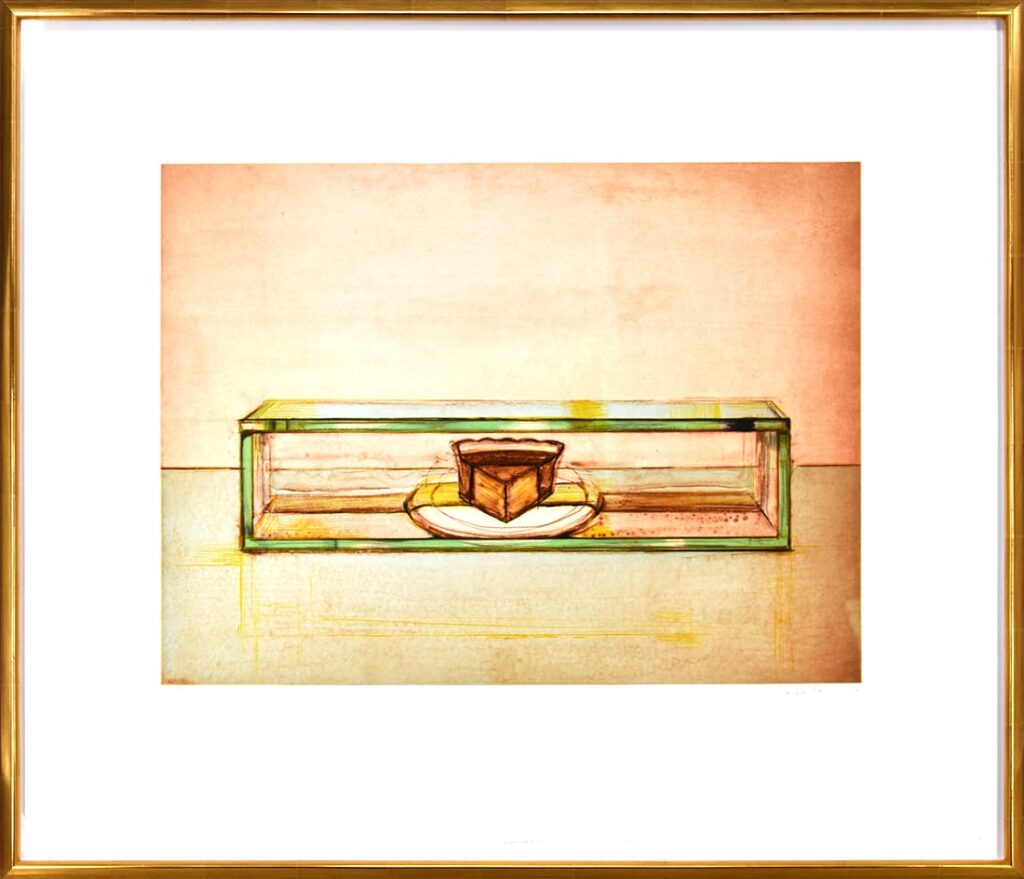
The Vibrant "San Francisco Streetscapes"
Thiebaud is also known for his vibrant paintings of San Francisco streetscapes. These lively and colorful representations of the city capture the energy and spirit of San Francisco. Thiebaud's unique perspective and use of color bring the city to life on the canvas, inviting viewers to experience the bustling streets and iconic landmarks. His San Francisco streetscapes have become iconic representations of the city and a testament to Thiebaud's ability to capture the essence of a place through his artwork.
Contribution to Printmaking
Wayne Thiebaud's contribution to the art world extends beyond painting. He has also made significant contributions to the field of printmaking, particularly at Crown Point Press. In the mid-1960s, Thiebaud made his first prints at Crown Point Press and continued to do so for the rest of his career. Thiebaud has experimented with different printmaking techniques, including lithography and etching, to create unique and captivating prints. His prints have the same vibrant colors and bold compositions as his paintings, but with the added depth and texture that printmaking techniques provide. Thiebaud's exploration of printmaking at Crown Point Press has expanded the possibilities of his artistic expression and has allowed him to reach a wider audience with his work.
Innovations in Etching and Woodcut
Wayne Thiebaud is not only known for his paintings but also for his innovations in printmaking, specifically etching and woodcut. Thiebaud's exploration of printmaking techniques allowed him to experiment with different textures and create unique works of art. His etchings and woodcuts showcase his meticulous attention to detail and his ability to create depth and dimension on a two-dimensional surface.
In his etchings, Thiebaud used acid to create intricate lines and textures on metal plates. This technique allowed him to achieve a high level of detail and precision in his prints. Thiebaud's woodcuts, on the other hand, involved carving intricate designs into wooden blocks and then applying ink to create prints. This process resulted in bold and dynamic images with a distinct texture.
Thiebaud's innovations in printmaking have had a significant impact on the art world. His prints are highly sought after by collectors and art enthusiasts. They showcase his versatility as an artist and his ability to push the boundaries of traditional techniques.
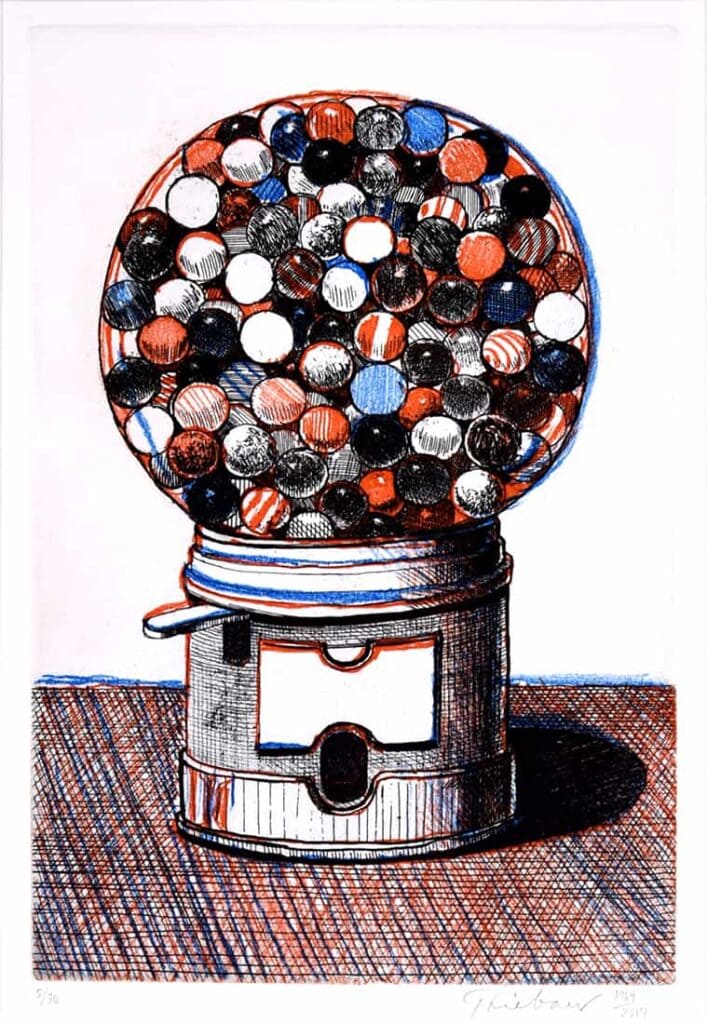
Limited Edition Prints and Their Impact
Limited edition prints have become a popular medium for artists to reach a wider audience and make their work more accessible. Wayne Thiebaud's limited edition prints have had a significant impact on the art world.
Limited edition prints are a way for artists to reproduce their original artwork in a limited number of copies. Each print is numbered and signed by the artist, making it a valuable and collectible piece of art. Thiebaud's limited edition prints often feature his iconic images of cakes, pastries, and cityscapes. These prints capture the vibrant colors and playful compositions that have made Thiebaud's work so popular.
Thiebaud's limited edition prints have allowed his art to be enjoyed by a wider audience. They have been exhibited in galleries and museums around the world, bringing Thiebaud's unique style and vision to art lovers everywhere. These prints have also become highly sought after by collectors, further cementing Thiebaud's status as a celebrated artist.
Teaching and Legacy
Wayne Thiebaud's impact on the art world extends beyond his own artwork. His contributions as a teacher and mentor have left a lasting legacy in the art community. Thiebaud's dedication to arts education was evident throughout his career. He taught at various institutions, including Sacramento City College and the University of California, Davis, where he mentored and inspired countless students. Thiebaud's teaching style emphasized experimentation, creativity, and a deep appreciation for the process of making art. His influence can be seen in the work of many younger artists who credit Thiebaud as a major inspiration and mentor in their own artistic journeys.
Influence on Future Generations of Artists
Wayne Thiebaud's impact on future generations of artists cannot be overstated. His unique style and approach to art have inspired countless younger artists to explore new avenues of creativity.
Thiebaud's emphasis on experimentation and his willingness to push the boundaries of traditional techniques have encouraged younger artists to think outside the box and challenge the status quo. Many artists credit Thiebaud as a major influence and mentor in their artistic journeys.
Thiebaud's teaching methods have also had a significant impact on the art world. His emphasis on the importance of process and the value of learning from mistakes has encouraged younger artists to embrace the challenges of creating art and to view setbacks as opportunities for growth.
Overall, Wayne Thiebaud's influence on future generations of artists is evident in the diverse and innovative work being produced today. His legacy as a teacher and mentor continues to inspire and shape the art world.
Thiebaud’s Philosophy on Art and Education
Wayne Thiebaud's philosophy on art and education is rooted in his belief in the transformative power of creativity. Thiebaud saw art as a means of self-expression and a way to explore and understand the world.
Thiebaud believed that art education should focus on nurturing creativity and providing students with the tools and techniques to express themselves visually. He emphasized the importance of studio art classes, where students could experiment with different mediums and techniques, and encouraged them to develop their own unique artistic voice.
Thiebaud also believed in the value of art education beyond the studio. He saw art as a way to foster critical thinking, problem-solving skills, and empathy. Thiebaud's philosophy on art and education continues to influence art educators and shape the way art is taught in schools and institutions around the world.
Exhibitions and Recognition
Wayne Thiebaud's artwork has been exhibited and recognized at prestigious institutions and galleries around the world. His unique style and iconic images have captivated audiences and solidified his place in the art world.
Thiebaud's major solo shows and retrospectives have been held at institutions such as the Pasadena Art Museum and the National Gallery of Art. These exhibitions have showcased the breadth and depth of Thiebaud's work, from his paintings of cakes and pastries to his vibrant cityscapes.
Thiebaud's artwork has also been recognized with numerous awards and honors throughout his career, including the National Medal of Arts. His contributions to the art world have left a lasting impact and continue to be celebrated by art enthusiasts and collectors alike.
Major Solo Shows and Retrospectives
Wayne Thiebaud's artwork has been the subject of major solo shows and retrospectives at prestigious institutions around the world. These exhibitions have provided audiences with a comprehensive look at Thiebaud's career and artistic evolution.
One notable exhibition was held at the Pasadena Art Museum in California. The exhibition showcased Thiebaud's iconic paintings of cakes, pastries, and everyday objects, highlighting his meticulous attention to detail and vibrant use of color. The exhibition was a critical and commercial success, solidifying Thiebaud's place as a celebrated artist.
Another significant retrospective was held at the National Gallery of Art in Washington, D.C. The exhibition featured a wide range of Thiebaud's work, including his landscapes, cityscapes, and still lifes. It highlighted his unique style and mastery of various mediums, including his sabbatical year in New York City where he made the acquaintance of leading American painters such as Robert Rauschenberg and Jasper Johns. This cemented his reputation as one of the most important American painters of his generation.
Awards and Honors Through the Years
Wayne Thiebaud's contributions to the art world have been recognized and celebrated with numerous awards and honors throughout his career. These accolades are a testament to his artistic talent and the impact of his work.
Thiebaud's most prestigious honor came in 1994 when he was awarded the National Medal of Arts by President Bill Clinton. This award is the highest honor given to artists by the U.S. government and recognizes individuals who have made significant contributions to the arts and culture.
In addition to the National Medal of Arts, Thiebaud has received numerous other awards and honors, including the Award of Honor from the San Francisco Arts Commission and the Cyril Magnin Award for Outstanding Individual Achievement in the Arts from the San Francisco Chamber of Commerce.
The following table provides a summary of the awards and honors Wayne Thiebaud has received throughout his career:
| Award/Honor | Year |
| National Medal of Arts | 1994 |
| Award of Honor from San Francisco Arts Commission | 1987 |
| Cyril Magnin Award for Outstanding Individual Achievement in the Arts | 1994 |
Conclusion
Wayne Thiebaud's art is a vibrant reflection of Americana, echoing his transition from commercial to fine art. His iconic works like "Cakes" and "Pies" capture everyday life with a unique use of light and color. Thiebaud's influence on printmaking and his innovative techniques have left a lasting legacy in the art world. Through major exhibitions and numerous awards, his distinctive style continues to inspire future generations. Delve into Thiebaud's world of thick paint application, shadow effects, and captivating compositions to appreciate the essence of his artistic journey.
Frequently Asked Questions
What Makes Wayne Thiebaud's Style Distinctive?
Wayne Thiebaud's style is distinctive for several reasons. His use of thick paint application creates texture and depth in his paintings. He also employs shadow effects to create a sense of volume and three-dimensionality. Thiebaud's bold color compositions and vibrant palette are also hallmarks of his unique style. As an American painter, his subject matter often reflects everyday objects and scenes, giving his work a relatable and familiar quality.
Wayne Thiebaud: Biography, Art, Paintings & Prints
Key Highlights
- Wayne Thiebaud is a renowned American painter known for his unique style that blends pop art and realism.
- He was awarded the National Medal of Arts for his contributions the art world.
- Thiebaud is famous for his paintings of cakes and pastries, as well as his vibrant San Francisco streetscapes.
- His thick paint application and use of shadow effects create a sense of texture and depth in his artwork.
- Thiebaud's paintings capture the essence of everyday Americana, making him an influential figure in American art.
- His prints and paintings are celebrated around the world for their vibrant colors and bold compositions.
Introduction
Wayne Thiebaud is an American painter and printmaker whose unique style has made him one of the most celebrated artists of his generation. Born on November 15, 1920, in Mesa, Arizona, Thiebaud's artistic journey began at a young age. He grew up in a large Mormon family and later moved to Long Beach, California. Thiebaud's early influences came from his experiences in Mesa and Long Beach, as well as his love for cartoons and commercial art. These early influences shaped his artistic style and set the foundation for his later works.
Thiebaud's artistic career took off during his time at the Frank Wiggins Trade School in Los Angeles, where he studied commercial art. He further honed his skills through a summer apprenticeship program at Walt Disney Studios, where he worked on beloved characters like Goofy and Pinocchio. Thiebaud's work in the animation department sparked his interest in fine art, leading him to explore different mediums and styles.
Early Life and Influences
Wayne Thiebaud's early life in Mesa, Arizona, shaped his artistic perspective. Inspired by cartoonists and commercial art, he honed his skills before transitioning to fine art.
Growing up in Mesa, Arizona
Wayne Thiebaud was born into a large Mormon family in Mesa, Arizona. His upbringing in a close-knit community instilled in him a strong sense of family values and community spirit. Thiebaud's early years in Mesa shaped his view of the world and influenced his artistic style. Later, his family moved to Long Beach, California, where Thiebaud continued to develop his artistic skills and explore his passion for art.
Inspiration from Cartoonists and Commercial Art
During his time in Long Beach, Thiebaud found inspiration in the world of cartoons and commercial art. He was particularly drawn to the work being done at Walt Disney Studios, where he later had the opportunity to work as a summer apprentice. Thiebaud's experiences at Disney fueled his love for animation and brought him closer to the world of fine art. The influence of cartoons and commercial art can be seen in his later works, as he combines elements of popular culture with his unique artistic style.
Artistic Journey
Wayne Thiebaud's artistic journey is marked by his transition from commercial art to fine art. After his time at Walt Disney Studios, Thiebaud continued his education in art, attending California State University in Sacramento. It was during this time that he began to explore different mediums and techniques, ultimately finding his signature style. Thiebaud's transition from commercial art to fine art allowed him to explore his creativity and delve into subject matters that were close to his heart.
Transition from Commercial Art to Fine Art
Thiebaud's transition from commercial art to fine art was a pivotal moment in his career. After completing his education at California State University in Sacramento, Thiebaud began teaching at Sacramento City College. This experience allowed him to further develop his own artistic style while imparting his knowledge to aspiring artists. Thiebaud's time at Sacramento City College cemented his passion for fine art and set him on the path to becoming one of the most influential artists of his generation.
Exploring the Everyday: The Theme of Americana
Thiebaud's exploration of the everyday is a recurring theme in his artwork. He captures the essence of Americana through his paintings of cakes, pastries, and everyday objects. Thiebaud's unique perspective on American culture and his ability to elevate seemingly ordinary subjects to the realm of fine art have made him a prominent figure in American art. His paintings resonate with viewers, evoking a sense of nostalgia and familiarity with the American experience.
Signature Style and Techniques
Wayne Thiebaud's signature style is characterized by his thick paint application and use of shadow effects. His paintings have a tactile quality that draws viewers in and invites them to explore the texture and depth of his artwork. Thiebaud's use of light and color in composition creates a sense of vibrancy and movement in his paintings. His unique techniques allow him to capture the essence of his subjects and create a visual experience that is both captivating and evocative.
Thick Paint Application and Shadow Effects
Thiebaud's thick paint application and use of shadow effects are distinctive elements of his artwork. He applies paint in layers, building up texture and depth to create three-dimensional effects on the canvas. This technique gives his paintings a tactile quality, inviting viewers to engage with the artwork on a deeper level. Thiebaud's use of shadow effects adds another layer of depth and dimension to his paintings, creating a sense of realism and capturing the play of light and shadow in everyday objects.
The Use of Light and Color in Composition
Thiebaud's use of light and color in composition is an integral part of his artistic style. He carefully selects colors to create harmonious compositions that evoke a sense of vibrancy and life. Thiebaud's skillful use of light effects adds depth and dimension to his paintings, capturing the interplay between light and shadow. His compositions are carefully arranged, with a keen eye for balance and visual impact. Thiebaud's mastery of color composition and light effects creates a visual experience that is both captivating and immersive.
Iconic Works
Delving into "Cakes" and "Pies," Wayne Thiebaud's iconic works mesmerize with their vibrant realism and playful compositions. The luscious textures of his paintings of cakes and pies evoke a sense of indulgence and nostalgia, capturing the essence of American culture. Thiebaud's "San Francisco Streetscapes" breathe life into city streets, portraying a dynamic urban landscape with a unique blend of colors and perspective, showcasing his mastery in capturing everyday scenes with a touch of whimsy and charm.
Delving into "Cakes" and "Pies"
Wayne Thiebaud's iconic works include his series of paintings featuring cakes and pies. These vibrant and enticing paintings have become synonymous with his name and are considered some of his most recognizable works. Thiebaud's depictions of cakes and pies capture the texture, color, and allure of these delectable treats. His unique blend of pop art and realism brings a sense of playfulness and nostalgia to these everyday objects, elevating them to the realm of fine art.
The Vibrant "San Francisco Streetscapes"
Thiebaud is also known for his vibrant paintings of San Francisco streetscapes. These lively and colorful representations of the city capture the energy and spirit of San Francisco. Thiebaud's unique perspective and use of color bring the city to life on the canvas, inviting viewers to experience the bustling streets and iconic landmarks. His San Francisco streetscapes have become iconic representations of the city and a testament to Thiebaud's ability to capture the essence of a place through his artwork.
Contribution to Printmaking
Wayne Thiebaud's contribution to the art world extends beyond painting. He has also made significant contributions to the field of printmaking. Thiebaud has experimented with different printmaking techniques, including lithography and etching, to create unique and captivating prints. His prints have the same vibrant colors and bold compositions as his paintings, but with the added depth and texture that printmaking techniques provide. Thiebaud's exploration of printmaking has expanded the possibilities of his artistic expression and has allowed him to reach a wider audience with his work.
Innovations in Etching and Woodcut
Wayne Thiebaud is not only known for his paintings but also for his innovations in printmaking, specifically etching and woodcut. Thiebaud's exploration of printmaking techniques allowed him to experiment with different textures and create unique works of art. His etchings and woodcuts showcase his meticulous attention to detail and his ability to create depth and dimension on a two-dimensional surface.
In his etchings, Thiebaud used acid to create intricate lines and textures on metal plates. This technique allowed him to achieve a high level of detail and precision in his prints. Thiebaud's woodcuts, on the other hand, involved carving intricate designs into wooden blocks and then applying ink to create prints. This process resulted in bold and dynamic images with a distinct texture.
Thiebaud's innovations in printmaking have had a significant impact on the art world. His prints are highly sought after by collectors and art enthusiasts. They showcase his versatility as an artist and his ability to push the boundaries of traditional techniques.
Limited Edition Prints and Their Impact
Limited edition prints have become a popular medium for artists to reach a wider audience and make their work more accessible. Wayne Thiebaud's limited edition prints have had a significant impact on the art world.
Limited edition prints are a way for artists to reproduce their original artwork in a limited number of copies. Each print is numbered and signed by the artist, making it a valuable and collectible piece of art. Thiebaud's limited edition prints often feature his iconic images of cakes, pastries, and cityscapes. These prints capture the vibrant colors and playful compositions that have made Thiebaud's work so popular.
Thiebaud's limited edition prints have allowed his art to be enjoyed by a wider audience. They have been exhibited in galleries and museums around the world, bringing Thiebaud's unique style and vision to art lovers everywhere. These prints have also become highly sought after by collectors, further cementing Thiebaud's status as a celebrated artist.
Teaching and Legacy
Wayne Thiebaud's impact on the art world extends beyond his own artwork. His contributions as a teacher and mentor have left a lasting legacy in the art community. Thiebaud's dedication to arts education was evident throughout his career. He taught at various institutions, including Sacramento City College and the University of California, Davis, where he mentored and inspired countless students. Thiebaud's teaching style emphasized experimentation, creativity, and a deep appreciation for the process of making art. His influence can be seen in the work of many younger artists who credit Thiebaud as a major inspiration and mentor in their own artistic journeys.
Influence on Future Generations of Artists
Wayne Thiebaud's impact on future generations of artists cannot be overstated. His unique style and approach to art have inspired countless younger artists to explore new avenues of creativity.
Thiebaud's emphasis on experimentation and his willingness to push the boundaries of traditional techniques have encouraged younger artists to think outside the box and challenge the status quo. Many artists credit Thiebaud as a major influence and mentor in their artistic journeys.
Thiebaud's teaching methods have also had a significant impact on the art world. His emphasis on the importance of process and the value of learning from mistakes has encouraged younger artists to embrace the challenges of creating art and to view setbacks as opportunities for growth.
Overall, Wayne Thiebaud's influence on future generations of artists is evident in the diverse and innovative work being produced today. His legacy as a teacher and mentor continues to inspire and shape the art world.
Thiebaud’s Philosophy on Art and Education
Wayne Thiebaud's philosophy on art and education is rooted in his belief in the transformative power of creativity. Thiebaud saw art as a means of self-expression and a way to explore and understand the world.
Thiebaud believed that art education should focus on nurturing creativity and providing students with the tools and techniques to express themselves visually. He emphasized the importance of studio art classes, where students could experiment with different mediums and techniques, and encouraged them to develop their own unique artistic voice.
Thiebaud also believed in the value of art education beyond the studio. He saw art as a way to foster critical thinking, problem-solving skills, and empathy. Thiebaud's philosophy on art and education continues to influence art educators and shape the way art is taught in schools and institutions around the world.
Exhibitions and Recognition
Wayne Thiebaud's artwork has been exhibited and recognized at prestigious institutions and galleries around the world. His unique style and iconic images have captivated audiences and solidified his place in the art world.
Thiebaud's major solo shows and retrospectives have been held at institutions such as the Pasadena Art Museum and the National Gallery of Art. These exhibitions have showcased the breadth and depth of Thiebaud's work, from his paintings of cakes and pastries to his vibrant cityscapes.
Thiebaud's artwork has also been recognized with numerous awards and honors throughout his career, including the National Medal of Arts. His contributions to the art world have left a lasting impact and continue to be celebrated by art enthusiasts and collectors alike.
Major Solo Shows and Retrospectives
Wayne Thiebaud's artwork has been the subject of major solo shows and retrospectives at prestigious institutions around the world. These exhibitions have provided audiences with a comprehensive look at Thiebaud's career and artistic evolution.
One notable exhibition was held at the Pasadena Art Museum in California. The exhibition showcased Thiebaud's iconic paintings of cakes, pastries, and everyday objects, highlighting his meticulous attention to detail and vibrant use of color. The exhibition was a critical and commercial success, solidifying Thiebaud's place as a celebrated artist.
Another significant retrospective was held at the National Gallery of Art in Washington, D.C. The exhibition featured a wide range of Thiebaud's work, including his landscapes, cityscapes, and still lifes. It highlighted his unique style and mastery of various mediums, cementing his reputation as one of the most important American painters of his generation.
Awards and Honors Through the Years
Wayne Thiebaud's contributions to the art world have been recognized and celebrated with numerous awards and honors throughout his career. These accolades are a testament to his artistic talent and the impact of his work.
Thiebaud's most prestigious honor came in 1994 when he was awarded the National Medal of Arts by President Bill Clinton. This award is the highest honor given to artists by the U.S. government and recognizes individuals who have made significant contributions to the arts and culture.
In addition to the National Medal of Arts, Thiebaud has received numerous other awards and honors, including the Award of Honor from the San Francisco Arts Commission and the Cyril Magnin Award for Outstanding Individual Achievement in the Arts from the San Francisco Chamber of Commerce.
The following table provides a summary of the awards and honors Wayne Thiebaud has received throughout his career:
| Award/Honor | Year |
| National Medal of Arts | 1994 |
| Award of Honor from San Francisco Arts Commission | 1987 |
| Cyril Magnin Award for Outstanding Individual Achievement in the Arts | 1994 |
Conclusion
Wayne Thiebaud's art is a vibrant reflection of Americana, echoing his transition from commercial to fine art. His iconic works like "Cakes" and "Pies" capture everyday life with a unique use of light and color. Thiebaud's influence on printmaking and his innovative techniques have left a lasting legacy in the art world. Through major exhibitions and numerous awards, his distinctive style continues to inspire future generations. Delve into Thiebaud's world of thick paint application, shadow effects, and captivating compositions to appreciate the essence of his artistic journey.
Frequently Asked Questions
What Makes Wayne Thiebaud's Style Distinctive?
Wayne Thiebaud's style is distinctive for several reasons. His use of thick paint application creates texture and depth in his paintings. He also employs shadow effects to create a sense of volume and three-dimensionality. Thiebaud's bold color compositions and vibrant palette are also hallmarks of his unique style. As an American painter, his subject matter often reflects everyday objects and scenes, giving his work a relatable and familiar quality.

